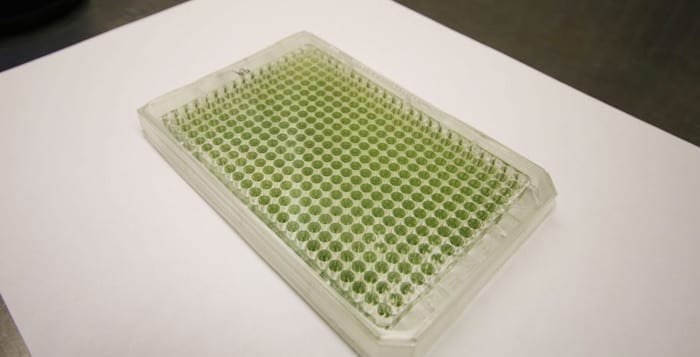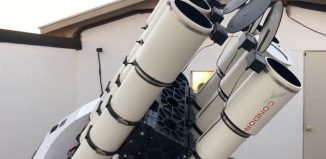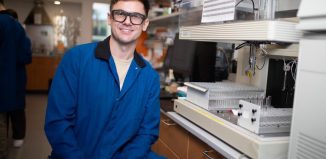BNL’s Ian Blaby looks for biofuel clues in algal metabolism
This is the second of a two-part series on Brookhaven National Laboratory’s Crysten and Ian Blaby.
While his wife is something of a metal worker, Ian Blaby is much more of a farmer. He cultivates rows upon rows of an unusual crop under numerous different conditions to see how they’ll grow and respond.
Like his wife Crysten Blaby, the organism he studies is a single-celled algae, which means those rows upon rows of crops can fit on the top of a bench, instead of dotting an expansive green field in the middle of the country.
Ian Blaby, who was born in Torquay, England, and earned his Ph.D. at Cambridge University, wants to know what genes are involved in carbon metabolism as the power algal couple look to unlock some important genetic secrets. The algae they study, Chlamydomonas reinhardtii, has 17,741 genes.
“We have a good idea what 5 to 10 percent of those genes are doing when it comes to the functioning of the cell,” Blaby said. Scientists have a vague idea for about another 40 percent, which means that about half of those genes are unknown. His goal is to figure out how the products of those genes, proteins, interact with each other.
Understanding these genes can translate into a better awareness of similar genes in more complex and diverse organisms, such as food and biofuel crops, Blaby said. The overlap and the potential for unlocking important genetic codes for more complex plants has led the Department of Energy to designate the alga a flagship species.
“It has been recognized as having a lot of potential,” Blaby said. He estimates there are about 100 labs around the world that are studying it.
John Shanklin, the head of the plant sciences group at BNL, likened the understanding of the genes of the algae to seeing the skyline of a city from a distance. While the view might provide information about where the buildings are, it doesn’t reveal much about what’s inside them. The information Ian and Crysten Blaby collect can provide greater insights about the genetic inner workings of this algae.
Additionally, Shanklin said medical researchers have been able to take studies done with yeast and apply them to human diseases. The similarities between algae and plants are two- to fourfold higher than they are between yeast and humans.
Discovering gene functions is “one of the, if not the, biggest problems in biology,” Blaby said. “Many, many labs around the world are tasked with addressing this. My approaches are not unique, but certainly very specialized.”
Indeed, using plastic grids that allow individual conditions in 384 small squares, Blaby can see how the alga grow and survive under a host of conditions, all at the same time. Blaby uses hundreds of these plates in any one experiment. He compares different strains under the same conditions of light, temperature or composition of the growth medium, or compares the same strains under different conditions.
Screening all those small squares would be laborious work and would invite human error.
“By the time we might be looking at plate 177, human error could creep in,” Blaby said. Instead, he uses robots to transfer the plates from incubators to readers. He gets real time information on how every strain is behaving under each condition.
When Blaby finds a plate where the growth is conspicuously different from the parent alga, he can go back and screen for the genetic differences. This can help him focus in on a particular genetic sequence.
“A different behavior can be assigned to a gene, or region of DNA, providing clues to a specific function which can then be followed up using other methods,” Blaby explained. This would be considerably harder and more difficult with crop plants that have more genes and a considerably longer time to produce the next generation.
Crop plants present numerous complications, including the time to grow, the space requirements, and the challenge of growing them under carefully controlled conditions, in addition to the different genes for roots and leaves, expressed in different cells.
For the algae, the doubling time is about eight hours, which means that this algae can be handled in a lab in a way that’s similar to bacteria.
Blaby’s interest in carbon metabolism stems from his post-doctoral work in Los Angeles.
“Carbon forms the basis of biofuel,” he said. He hopes to identify “novel genes that are involved in fuel production but that weren’t known.”
While scientists like Crysten and Ian Blaby are studying single-celled algae in their lab, they have the big picture goal of the application and translation of their work to a real-world problem and limitation that will affect future generations of people.
“We’re making more people, but we don’t have more land area for growing crops,” Shanklin said. “The only options are to grow crops” on currently unused land or to “make the growth more efficient. We’re working on both sides.”
The BNL department has a mandate, along with other researchers working with the DOE, to “make plants more efficient. We can’t do that if we don’t know what the genetic parts are of the plants” that are important for survival in different conditions, Shanklin added.
In addition to hiring Ian and Crysten Blaby and Qun Liu this fall, BNL is in the process of working with the DOE on long-term planning. “We’re looking at how big this program can become,” Shanklin said. He is excited about the work Ian and Crysten Blaby are doing. “It’s not enough to work hard,” he said. “You have to identify big problems and work on those. The problems they are addressing are ones that are holding back whole elements of science.”
Shanklin sees Ian and Crysten Blaby as contributing more together than the sum of their research parts. “They are both independently excellent scientists who have different but complementary skill sets,” he added.
This version corrects the name of the type of algae Ian Blaby is studying and the town in England where he is from.







